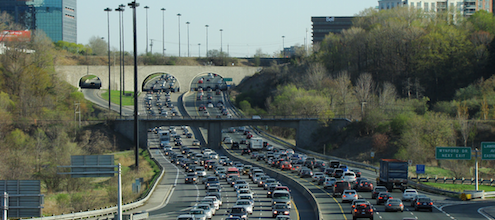
Opinion: Ending tolls provides a clean slate for mobility pricing in Metro Vancouver
At first blush, the provincial government’s decision to remove tolls on the Port Mann and the Golden Ears bridges looks like a setback for tackling Metro Vancouver’s crippling traffic. Tolls provide a clear incentive to drive less, take transit or drive at different times. It seems like the province has shifted into reverse.
But dropping tolls represents an opportunity for a more comprehensive approach to reducing traffic. The tolls have long been a point of contention. Perhaps counterintuitively, eliminating these tolls cleans the slate for a renewed dialogue about mobility pricing.
Removing the tolls was about fairness, not reducing congestion. Any commuter crossing the Fraser River is happy to point out, it’s unfair to pay for bridge crossings while residents elsewhere use the region’s 20 other bridges for free. The provincial government campaigned to correct this regional imbalance and made good on its promise.
Yet, we can’t ignore the bigger issue: congestion in Metro Vancouver is bad and getting worse. The region continues to grow and densify, with more cars on the road. Expanding the road network is not a long-term solution. Rising traffic volumes will offset temporary reductions in congestion.
Removing tolls will certainly not improve traffic. In fact, it may encourage people to drive more. No longer paying $3 to $9 per crossing could change drivers’ math, leading to an overall increase in the number of crossings.
But tolling only two bridges hasn’t been effective either. Hundreds of drivers have been avoiding the Port Mann Bridge every day, seeking un-tolled alternatives. Congestion is a regional problem that requires a lasting, regional solution.
The only tool that can really reduce traffic is mobility pricing. Broadly defined, mobility pricing is about how we pay for all forms of transportation, and how fees and charges can create a more efficient and balanced transportation system. This could mean tolling all the bridges or charging based on when and where we travel. Prices could even be harmonized with transit fares to send consistent signals across the transportation system.
For drivers, mobility pricing could mean paying a small fee to use the roads during peak periods. The price charged would reflect the costs that each of us impose on the road network: my decision to drive at 8:30 on a Monday morning is an inconvenience to others. It costs everyone in terms of their time (e.g., less time for other, more enjoyable things), and leads to more air pollution and accidents. In return for paying a nominal fee, we save time, money, and maybe our sanity.
Those crossing the Port Mann and Golden Ears are fed up with paying tolls that others are not. Fair enough. But no matter where you live in the region, we all complain about the amount of traffic. And removing two bridge tolls will do nothing to curb congestion and could even make it worse.
However, the solution isn’t less pricing, it’s broader and consistent pricing. Comprehensive and regionwide mobility pricing — currently being studied by the Mobility Pricing Independent Commission — could apply to all transportation in Metro Vancouver and result in less traffic. That is exactly why ridding the region of tolls in the short term cleans the slate for a fairer, efficient and more comprehensive approach moving forward.
Nancy Olewiler is a professor of public policy at Simon Fraser University and a commissioner with Canada’s Ecofiscal Commission. Jonathan Arnold is a research associate with the commission.
This piece was originally published by Vancouver Sun on September 4, 2017.




Comments are closed.